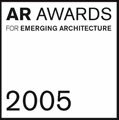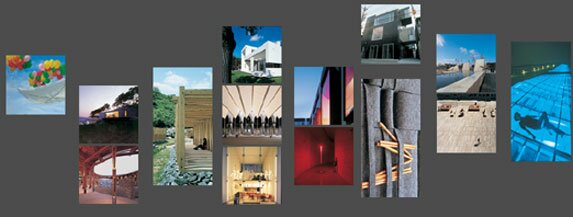

2002
the jury for 2002
2001
winners 2001
press release 2001
winners comments 2001
2000
winners 2000
the event 2000
1999
winners 1999
Images of winning and commended schemes
The jury* of this year's ar+d award was almost overwhelmed by an explosion of talent of young architects and designers from all over the world. In the end, eight prize winners were chosen (four of them with distinction).
They were honoured at the Danish Design Centre in Copenhagen on 29 November. Taiko Shono won an award for her amazing urban landscape at Onahama in Japan which poetically interprets sensual experiences of the sea. Meck + Köppel's cemetery complex at Riem in Germany gives great dignity and grace to rites of passage, as does the mortuary in León, Spain built in very difficult circumstances by BAAS. At the urban scale, Atelier 4d were premiated for revitalising the central spaces of Namur, the capital of Wallonia in Belgium, and so were Barkow Leibinger for their outstanding contribution to the texture of Potsdam, Germany, one of the most delicate urban and landscape fabrics in the world.
TEN Arquitectos were given an award for their remarkable transformation of a dull office block in Mexico City into a magical shadow theatre of a hotel, and Silja Tillner washonoured for transforming another old building, the Vienna Town Hall, by using a retractable roof over the main courtyard. Most surprising to the jury was the fact that Jae Cha, who was premiated last year for her chapel in Bolivia, won an award this time for a community centre in Honduras: her work shows architectural imagination honed to finest edge by the necessities of poverty.
Eighteen other projects were chosen by the jury for special commendation. They include work as different as the government building in Svalbard in the Arctic (the world's most northerly settlement) and a joyous colourful balloon pavilion in Thailand. A gentle home for the mentally handicapped in Korea contrasts with a rigorous new management school in Ahmedabad, India. A mysterious luminous installation in the heart of a hill in Berlin could not be more different from the functionality of a tyre changing shop in Zurich. Houses in Peru, Spain, Australia demonstrate how young architects respond to differences in climate, culture and resources with traditional setting-up commissions. New approaches to urban building in Salzburg, Austria and Osaka, Japan show inventive flair for using modern technology and management systems that could transform our cities and make life decent for rich and poor alike. The jury was happy to recognise small-scale work like the Ichneumon office space divider and the ingenuity of the industrialised construction of a restaurant in Kawasaki-shi, Japan.
The annual ar+d award was set up by The Architectural Review** and d line*** in 1999 to celebrate the work of a generation of architects who have as yet been scarcely recognised. Only constructed projects are eligible. Often, the award celebrates the critical progression from theoretical work to built form. And it signals the moment when a new individual talent (or group of collaborative talents) emerges with confidence and authority.
The award is truly international, as the range of the more than 700 entries from nearly 60 countries demonstrates. Entries came from places as far apart as Serbia and Singapore, Peru and Portugal, Japan and Jamaica, Uruguay and the Ukraine.
The ar+d award's inventors are d-line international as, the distinguished Danish architectural design firm, and the London-based Architectural Review, the international magazine which celebrates excellence in the creation of the human-made world. Results are published in full in The Architectural Review's December issue.
Award winners will share the UK £ prize money, and will receive trophies by the Danish designer Knud Holscher.
Peter Davey, Editor of The Architectural Review and chairman of the jury, said that 'We were all amazed and very pleased by the quality and imagination of the entries. Undoubtedly, the Award is growing in authority and in the quality of the work submitted. Clearly, there is a wonderful unknown continent of young talent which the Award has only begun to explore.'
For further information contact
Peter Davey, The Architectural Review,
*The jurors were Alberto Campo Baeza (Madrid), Craig Dykers (Snøhetta, Oslo), Francine Houben (Mecanoo, Delft), Louisa Hutton (Sauerbuch & Hutton, Berlin and London), and Peter Davey (Jury chairman and Editor of The Architectural Review).
**The Architectural Review has the largest international circulation of any architectural publication in the world. It was founded in 1896, and has been published continuously ever since. It covers theory,
urbanism, landscape, product and interior design as well as buildings
*** d line international as has worked internationally for over 25 years, specialising in work related to the architectural ironmongery market. d line products are designed by Knud Holscher, architect and professor at the Royal Danish Academy. The products are distributed in more than 40 countries.
Images of winning and commended schemes